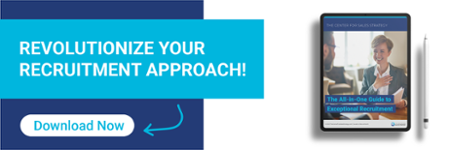
In the “old days” (5 years ago), hiring a new employee meant meeting them in person, shaking their hand, and conducting a live interview.
Today, that’s not always possible.
For many, remote and hybrid models are becoming the norm, which means leaders must adapt their recruitment strategies to meet the unique challenges and opportunities these environments present.
Here’s how leaders can fine-tune their approach to attract and assess top talent effectively.
Set the Bar: Identify Your Ideal Candidate
Begin by considering the Talents, Skills, and Experiences that are critical to success in the job role, and make a list of your “must-haves.”
When filling a remote or hybrid position, consider setting the bar high for talents like work ethic and discipline and skills like time management and digital communication.
Attract Top Talent: Write Compelling Job Postings That Cut Through the Clutter
With your “must have” list in hand, create a job description that will jump off the screen to candidates who fit the bill. Also, make sure to highlight the benefits and expectations of working remotely.
Emphasize flexibility, work-life balance, and the company’s commitment to supporting remote employees. Gain extra traction by asking your team to post your job ad on social media and send it directly to likely candidates.
Leverage Employee Referrals and Get the Inside Scoop
Remember that your current employees are likely your very best connection to future talent. Employees who refer candidates are more likely to recommend those who align with the company’s values and possess the required talents and skills, leading to a higher chance of finding qualified candidates who are a good fit.
Consider implementing a structured employee referral program that incentivizes team members to recommend potential candidates. This strategy not only helps in finding suitable candidates but also increases employee engagement and loyalty.
Go Beyond the Inner Circle to Your Larger Referral Network
While employee referrals are valuable, don’t stop there! Nine years of research have shown that referrals far and away generate the largest number of superstar hires.
Make a list of friends, family, clients, and business connections you can reach out to. Then, turn your must-haves into a referral request that starts with the words, “Who do you know who?” This might sound like, “Who do you know who is energized by tackling complex situations, extremely organized in their approach, and thrives on helping others?”
Build a Robust Online Employer Brand
If you haven't Googled your own company recently, take a few minutes to do that today. It will help you understand your current employer brand and the content your potential job candidates are seeing online.
It will give you the opportunity to address any issues you find and make them right.
A strong online presence showcases the company culture and values, which is crucial when candidates cannot experience the office environment firsthand.
Use the company website, blogs, and social media to share stories of remote team successes, testimonials from employees, and insights into the company’s remote work policies.
Eliminate the Guesswork: Understand Their Strengths and Weaknesses
As online recruiting and hiring have become more common, so has the need for a validated assessment to help you find talents that are hard to spot over the phone and video.
When the time is right, ask them to complete a validated talent assessment that aligns with the specific job role you are filling. This will help you bring the right people on board, put them in the right seats, and develop them to grow over time.
After they complete the assessment, schedule time with a certified Talent Analyst to learn more about how their talents may align with your “must haves” and discuss the behaviors you should expect to manage in the role. Ask questions about any red flags you may have seen and discuss the interview questions you should use in a one-on-one interview to better understand whether they are the right fit for your role.
When hiring for a remote position, pay close attention to whether this person is likely to thrive working autonomously or whether they will need more oversight.
Master the Remote Interview
With a clear understanding of their strengths and weaknesses—and how they align with what you need—it’s time to get to know them and learn even more. With just a little bit of planning, this can easily be done virtually over a shared screen.
Spend a little time planning your questions in advance so you are prepared for a great conversation. Remember, you won’t need to determine if they have the talents for success because their talent assessment provided you with that information. Instead, build questions that will help you get to know them as a person, learn more about the skills they’ve developed and the experience they bring, and decide whether they would make a good addition to your team.
Your interview is also your opportunity to win them over. Make sure you highlight your employer brand and provide great examples of why your company is a great place to work. We recommend that you leave them with their Top Talent Report, which they will find highly valuable.
Take Advantage of Virtual Work Simulations
Often, the best way to understand a person is to see them in action. To gauge your candidate’s fit for the job, consider virtual work simulations that mimic actual tasks they would perform. This will give you clear insight into their problem-solving abilities, time management, and comfort with remote work tools.
Focus on Cultural Fit
Cultural fit is even more critical in a remote environment where team cohesion can be challenging to build. During the interview process, ask questions that will reveal a candidate’s alignment with the company’s values and their ability to collaborate and contribute to a team remotely.
Don’t Leave Them Hanging
Clear and consistent communication throughout the recruitment process builds trust and keeps candidates engaged. Provide regular updates on the process, next steps, and timelines.
Invest in Effective Onboarding
Before you make that job offer, make an onboarding plan that will quickly help your new employee integrate with the rest of the team and start building a sense of connection. Virtual meet-and-greets, online training sessions, a work buddy, and regular check-ins can help new hires feel connected and supported from the start.
Conclusion
By embracing these strategies, leaders can not only attract but also effectively assess candidates in a remote or hybrid work environment, ensuring that the organization continues to thrive with a strong, cohesive team no matter where they’re located.






